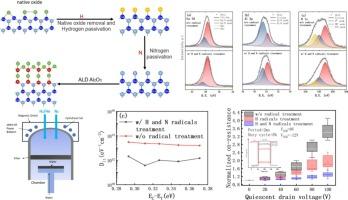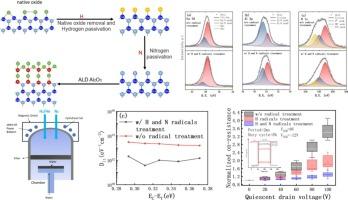In situ hydrogen and nitrogen radicals surface modification of aluminum gallium nitride for high-performance aluminum gallium Nitride/Gallium nitride MIS-HEMTs fabrication
IF 6.9
2区 材料科学
Q2 CHEMISTRY, PHYSICAL
引用次数: 0
Abstract
A radical-based surface treatment technique was developed for high performance Al2O3/AlGaN/GaN MIS HEMTs fabrication. In-situ H and N radicals were used on AlGaN surface to remove the surface native oxides, restore nitrogen vacancies, and passivate surface states. With the radicals surface treatment, the interface states () of Al2O3/AlGaN were reduced by approximately one order of magnitude. Consequently, the manufactured MIS HEMT demonstrated excellent performances: stable threshold voltage () characteristics, high on/off current ratio () of up to , gate leakage current as low as 1nA/mm, minimal current collapse, and under a drain voltage stress of 100 V, the increase in dynamic on-state resistance improves from approximately 240 % to around 30 %. Furthermore, from the perspectives of surface morphology and channel mobility, the radicals surface treatment process appears to be non-destructive, which may be attributed to the avoidance of damage from charged particle bombardment, showcasing its great potential for high-performance AlGaN/GaN HEMTs fabrication.


氮化铝镓原位氢氮自由基表面改性制备高性能氮化铝镓/氮化镓miss - hemt
研究了一种基于自由基的表面处理技术,用于制备高性能Al2O3/AlGaN/GaN MIS hemt。在AlGaN表面使用原位H和N自由基去除表面天然氧化物,恢复氮空位,钝化表面状态。通过自由基表面处理,Al2O3/AlGaN的界面态(DitDit)降低了约一个数量级。因此,制造的MIS HEMT表现出优异的性能:稳定的阈值电压(VTHVTH)特性,高开/关电流比(ION/IOFFION/IOFF)高达108108,栅极泄漏电流低至1nA/mm,电流崩溃最小,并且在100 V的漏极电压应力下,动态导通电阻的增加从约240 %提高到约30 %。此外,从表面形貌和通道迁移率的角度来看,自由基表面处理过程似乎是非破坏性的,这可能归因于避免了带电粒子轰击的损伤,显示了其在高性能AlGaN/GaN hemt制造中的巨大潜力。
本文章由计算机程序翻译,如有差异,请以英文原文为准。
求助全文
约1分钟内获得全文
求助全文
来源期刊

Applied Surface Science
工程技术-材料科学:膜
CiteScore
12.50
自引率
7.50%
发文量
3393
审稿时长
67 days
期刊介绍:
Applied Surface Science covers topics contributing to a better understanding of surfaces, interfaces, nanostructures and their applications. The journal is concerned with scientific research on the atomic and molecular level of material properties determined with specific surface analytical techniques and/or computational methods, as well as the processing of such structures.
 求助内容:
求助内容: 应助结果提醒方式:
应助结果提醒方式:


